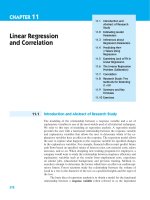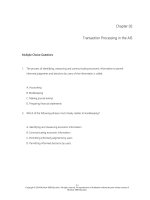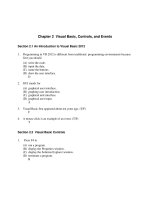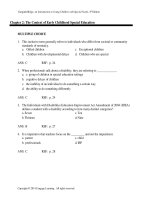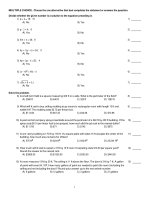Java foundations introduction to program design and data structures 4th edition lewis test bank
Bạn đang xem bản rút gọn của tài liệu. Xem và tải ngay bản đầy đủ của tài liệu tại đây (245.41 KB, 12 trang )
Java Foundations Introduction to Program Design and Data Structures 4th edition Lewis
Test Bank
Link full download test bank: />
Chapter 2: Data and Expressions
Multiple Choice Questions:
1) Which of the following are examples of invalid string literals?
a)
b)
c)
d)
e)
"Hello World!"
"4 score and 7 years ago, our forefathers brought forth..."
"z"
""
none of the above
Answer: e
Explanation: A string literal can contain any valid characters, including numeric digits, punctuation and other special
characters. They can also contain no characters at all.
2) A(n)
is a piece of data that we send to a method.
a) parameter
b) object
c) escape sequence
d) service
e) expression
Answer: a
Explanation: A parameter is a piece of data sent to a method. An object may not be sent to a method directly
(although you can send a reference to an object as a parameter). An escape sequence is used to represent special characters in a
string literal. A service is the action that a method provides to a program. An expression is a combination of operators and
operands that produces a result.
3) Which of the following is an example of an invalid assignment or declaration statement?
a) int age = 30;
b) int money, dollars = 0, cents = 0;
c) int years = 1; months = 12; days = 365;
d) int length, meters, centimeters, millimeters;
e) none of the above
Answer: c
Explanation: A declaration/assignment statement cannot have multiple declaration/assignments separated by semicolons since a semi-colon denotes the end of a statement in Java.
1
Pearson © 2017
4) Java has two basic kinds of numeric values:
which do.
, which have no fractional part, and
a) shorts, longs
b) doubles, floating points
c) characters, bytes
d) integers, floating points
e) integers, longs
Answer: d
Explanation: All numeric data types are either floating point data types, which have fractional parts (e.g. float,
long) or integer data types which have no fractional parts (e.g. byte, short, int, long).
5) To assign a value stored in a double variable to an int variable, use
a) a cast operator
b) promotion
c) a print statement
d) a widening conversion
e) nothing. Java will do this automatically
Answer: a
Explanation: This is a narrowing conversion. A cast operator must be used to perform a narrowing conversion.
6) Which of the following is not an arithmetic operation in Java?
a) +
b) c) *
d) %
e) These are all arithmetic operations in Java
Answer: e
Explanation: All of these operators can be used as part of an arithmetic expression in Java. They represent the
addition, subtraction, multiplication and remainder operators respectively.
7) Which modifier must be used in the declaration of a variable to make it a constant?
a)
b)
c)
d)
e)
public
final
static
void
private
Answer: b
Explanation: The final modifier makes a variable a constant, meaning that its value cannot be reassigned.
2
Pearson © 2017
8) Which of the following data types only allows one of two possible values to be assigned?
a) char
b) int
c) boolean
d) float
e) long
Answer: c
Explanation: Variables of type boolean can only be assigned values of true or false. The other four types can be
assigned many different values.
9) Which of the following is an example of an invalid expression in Java?
a)
b)
c)
d)
e)
result
result
result
result
result
=
=
=
=
=
a + b;
(14 + 9) * 5;
((19 + 4) - 5;
firstNum % secondNum;
firstNum / secondNum % thirdNum;
Answer: c
Explanation: All of these expressions are valid except for c, which has mismatched parenthesis. This will generate a
compiler error.
10) A
is a list of characters in a particular order. Examples include ASCII and Unicode.
a) character literal
b) character set
c) char data type
d) control character
e) none of the above
Answer: b
Explanation: A character set is a list of characters in a particular order. Java uses the Unicode character set. A
character literal is an explicit character in a Java program and is denoted by surrounding it with single quotes. The char data
type is a primitive data type in Java and a control character is a nonprinting or invisible character that does not have a symbol to
represent it.
11) A user types the number -12.6 in response to a prompt in a program. Which Scanner class method should be used to read
the user input as a numeric value?
a)
b)
c)
d)
e)
nextInt()
nextDouble()
nextNegative()
next()
any of these methods will work
Answer: b
Explanation: The user input contains a decimal point, so it cannot be read as an int. The next() method will read it
in as a String, not as a numeric value.
3
Pearson © 2017
12) Which of the following lines allows a programmer to use the Scanner class in a Java program?
a)
b)
c)
d)
e)
import java.util.Scanner;
using Scanner;
include Scanner;
include java.util.Scanner;
any of the above will allow the programmer to use the Scanner class
Answer: a
Explanation: The Scanner class must be imported using the import command before it may be used in a program.
13) Consider the following snippet of code:
System.out.println("30 plus 25 is " + 30 + 25);
What is printed by this line?
a)
b)
c)
d)
e)
30 plus 25 is 55
30 plus 25 is 30
30 plus 25 is 25
30 plus 25 is 3025
this snippet of code will result in a compiler error
Answer: d
Explanation: In this case, the + symbol represents the concatenation operator, not addition. Therefore, the println
method will output the concatenation of 30 plus 25 is, 30, and 25. If we wanted to print out the sum of 30 and 25, we must put
the sum in parentheses.
14) Consider the following snippet of code:
int firstNum = 25;
int seconNum = 3;
double result = 25/3;
System.out.println(result);
What is output by this code?
a)
b)
c)
d)
e)
8.0
8.333333333
8
8.3
This snippet of code will result in a compiler error
Answer: a
Explanation: The right hand side of the assignment statement in the third line results in an integer because the two
operands are integers. Specifically, it yields 8. The left hand side of the expression is of type double,so assignment conversion
occurs. Therefore, result holds 8.0. This is what will be printed by the println statement.
4
Pearson © 2017
15) Information is most likely to be lost in what kind of data conversion?
a) A widening conversion
b) A narrowing conversion
c) promotion
d) assignment conversion
e) no information will be lost in any of the conversions listed above
Answer: b
Explanation: A narrowing conversion is most likely to result in information loss since you are changing a piece of data
from a data type that can hold more information into a data type that can hold less information. The other three types of
conversions are all widening conversions, and therefore do not lose any information.
5
Pearson © 2017
True/False Questions:
1) The print and the println methods are identical and can be used interchangeably.
Answer: False
Explanation: The println method prints the information sent to it, then moves to the beginning of the next line.
The print method does not advance to the next line when completed.
2) A String literal may span multiple lines in the program code.
Answer: False
Explanation: A string literal may not span multiple lines. If a programmer wishes to have part of a string literal on one
line and part on another line, she must separate the single literal into two literals, and use the concatenation operator (+).
3) Java is a strongly-typed language.
Answer: True
Explanation: Java is strongly-typed, which means we cannot assign values to a variable that are inconsistent with its
declared type without generating a compile time error.
4) Variables declared with the final modifier cannot have new values assigned to them.
Answer: True
Explanation: The final modifier makes a variable a constant.
5) The byte type can be assigned a larger range of numbers than the int type.
Answer: False
Explanation: The int type can hold numbers in the range -2,147,483 to 2,147,483,647 while the byte type can only
hold numbers in the range -128 to 127.
6) Java uses the ASCII character set to represent character data.
Answer: False
Explanation: Java uses the Unicode character set to represent characters, since it supports more unique characters and
can therefore represent the world's many alphabets better.
7) After the execution of the code below:
int counter = 9;
int result = counter++;
variable result contains the value 9.
Answer: True
Explanation: The expression counter++ uses the postfix form of the increment operator. Its value, 9, is assigned to
result, then the value in counter is incremented to 10.
8) The type of result produced by a mathematical expression depends on the types of the operands.
Answer: True
Explanation: The types of the operands dictate the data type to which an expression evaluates. An important example
of this is arithmetic division, which will always result in an integer when the expression's operands are integers.
9) Promotion is a widening data conversion that is explicitly requested by the programmer.
Answer: False
Explanation: Promotion is an explicit conversion that happens when operators need to modify their operands to
perform the operation. For example, when an integer is divided by a floating point number, the integer will be promoted to a
floating point number so that the division operator is acting on two floating point types.
6
Pearson © 2017
10) The Scanner class must be imported using the import statement before it can be used in a program.
Answer: True
Explanation: The Scanner class is part of the java.util package which is not imported automatically.
7
Pearson © 2017
Short Answer Questions:
1) Write an application that prints out the following using a single call to the print method.
Hello!
How
are you?
Answer:
public class QuestionOne {
public static void main(String [] args) {
System.out.print("Hello!\nHow\nare you?");
}
}
2) Write a single println statement that prints out the following line.
"There is Thingumbob shouting!" the Bellman said,
Answer:
System.out.println("\"There is Thingumbob shouting!\" the Bellman said,");
3) Write a short program that declares a single integer variable called age and assigns it a value equal to your age. Also have it
print out your age using the age variable. The output of your program should look similar to the following:
I am 30 years old.
Answer:
public class MyAge {
public static void main(String [] args) {
int age = 30;
System.out.println("I am " + age + " years old.");
}
}
4) Write a single line of Java code that computes the average of three integer variables – num1, num2, and num3 – and
stores the result in a variable of type double called result.
Answer: Note that in order to compute an accurate average, we must avoid integer division. This can be achieved by
making one of our operands a floating point value. In this solution, we divide by 3.0 to yield floating point division on the right
hand side of the expression.
double result = (num1 + num2 + num3)/3.0;
8
Pearson © 2017
5) Suppose your numeric grade is calculated using the following formula:
Test 1: 15%
Test 2: 15%
Final Exam: 30%
Homework: 10%
Programming Projects: 30%
Determine a good variable name to represent each of these values. Write a single expression to compute your grade
assuming the variables have been declared and each one stores its value as an integer in the range 0 to 100.
Answer:
double grade = test1*.15 + test2*.15 + exam*.3 + homework*.1 + projects*.3;
6) Write a short application that converts inches to centimeters. It should read the number of inches from the user as a floating
point number and output the number of inches and the number of centimeters at the end of the program. Note that there are
2.54 centimeters in an inch.
Answer:
import java.util.Scanner;
public class InchesToCentimetersConversion {
public static void main(String [] args) {
double inches;
double centimeters;
Scanner input = new Scanner(System.in);
System.out.print("Please enter the number of inches: ");
inches = input.nextDouble();
centimeters = inches*2.54;
System.out.println(inches + " inches is equivalent to "
+ centimeters + " centimeters.");
}//end main
}//end class
9
Pearson © 2017
7) Consider the following snippet of code.
int iResult;
float fResult;
int rResult;
int iNum1
int iNum2
iResult =
rResult =
fResult =
= 25;
= 8;
iNum1/iNum2;
iNum1%iNum2;
(float) iNum1/iNum2;
What values are stored in iResult, rResult, and fResult? Explain your answers.
Answer:
The value that is stored in iResult is 3. This is the result of dividing 25 and 8 using integer division. The value that
is stored in rResult is 1. This is the remainder of dividing 25 and 8 using integer division. The value that is stored in
fResult is 3.125. This is the result of dividing 25 and 8 using floating point division. In the expression, iNum1 is explicitly
cast as a floating point value which causes iNum2 to be promoted to a floating point value. The division is then floating point
division.
8) Write a short program that allows the user to enter the year that they were born (as an integer) and outputs the age that they
will be at the end of this year. Declare the current year as a constant.
Answer:
import java.util.Scanner;
public class AgeThisYear {
public static void main(String [] args) {
final int CURRENT_YEAR = 2017; // adjust as appropriate
int age, birthYear;
Scanner scan = new Scanner();
System.out.print("Enter the year of your birth: ");
birthYear = scan.nextInt();
age = CURRENT_YEAR – birthYear;
System.out.println("You will be " + age + " at the end of"
+ " this year.");
}//end main
}//end class
10
Pearson © 2017
9) What are some reasons that you might want to declare a variable as final?
Answer: A variable that is declared as final is one that cannot be reassigned throughout the program. You might
want to declare a variable as final if its value will not change during program execution. This will make it so you cannot
accidentally change the value by reassigning it which can cause errors. It also will allow you to change the variable in a single
place in the program if and when the value does change.
10) Write a short application that computes the perimeter of a rectangle. It should allow the user to input the length and width
of the rectangle as a double.
Answer:
import java.util.Scanner;
public class Perimeter {
public static void main(String [] args)
double length, width, perimeter;
{
Scanner scan = new Scanner();
System.out.print("Enter the length of the rectangle: ");
length = scan.nextDouble();
System.out.print("Enter the width of the rectangle: ");
width = scan.nextDouble();
perimeter = length*2 + width*2;
System.out.println("The perimeter of the rectangle is "
+ perimeter + " inches.");
}//end main
}//end class
11) Consider the following snippet of code:
int firstNum = 5;
int secondNum = firstNum++;
int thirdNum = 6*(++firstNum);
What values are stored in firstNum, secondNum and thirdNum after these lines are executed? Explain your answer.
Answer: After the first two lines are executed, secondNum will contain 5 and firstNum will contain 6. This is
because the increment operator is after the variable, which means that the assignment will happen before firstNum is
incremented. After the third line is executed, firstNum is 7 and thirdNum is 42 (which is 6*7). This is because the
increment operator is before firstNum, which means that firstNum is incremented to 7, and then the expression is
evaluated.
11
Pearson © 2017
12) For the following expression, indicate the order that in which the operators will be evaluated.
a + b * c / (d - e)
Answer: The subtraction (d – e) will be evaluated first since it is in parentheses. Next, the multiplication b*c
will be evaluated and then the division operation will be evaluated. Finally, the addition will be performed.
13) Explain why it might not be safe for a programmer to use a narrowing conversion.
Answer: A narrowing conversion might not be safe because it can result in information loss. This is because in a
narrowing conversion a programmer is changing a piece of data from a data type that can hold more information into a data
type that can hold less information.
14) How are primitive data types and object data types related?
Answer: Object types are more complex data types, and they are generally made up of primitive data types.
15) Explain the difference between the print and the println methods.
Answer: The println method performs a carriage return after printing the specified characters. This means the
next output will begin on the next line. The print method does not do this, and therefore the next output will begin right
after the previous output.
12
Pearson © 2017

